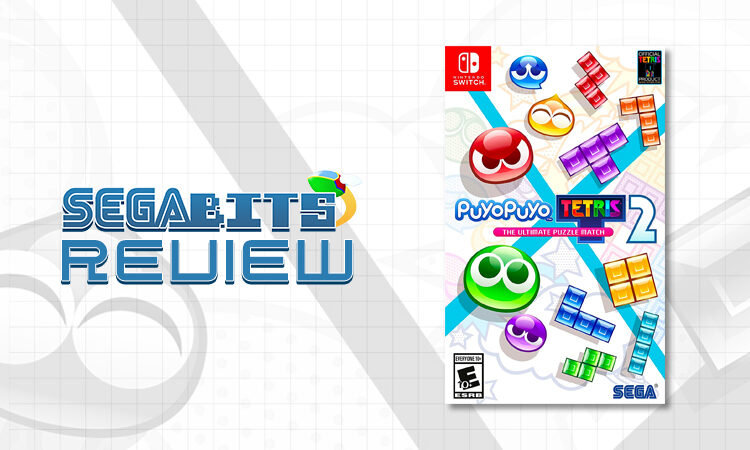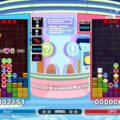Review code provided by SEGA
Puzzle games! They’re fun! They’re varied! They’re kind of strange to talk about, too, they’re very weird and specific in that way. Why do you play them? I play them because I want something fun and simple that puts my brain to work, or to put my brain against some other person’s brain and see who can work their brain better, or something. And that’s awesome! I love these games!
But there’s a lot of them. Puyo Puyo and Tetris are two of the biggest puzzle games on the planet, they have such long, storied histories, they play in such similar yet contrasting ways, it’s fascinating playing a game that has them both in one package. But it’s also not the only time they’ve been in one package. When I previewed this game, I mentioned how it was comforting how little had changed between games, because it meant I was gonna have a good time regardless of which one I booted up. But now that it’s out, I gotta ask myself: does that comfort hold up after a few weeks of playing?
This review is not written under the pretense that you don’t know what a Teris or Puyo Puyo is. I write this with the thought that you know what one of those is, and you’re wondering if this is a good version. This is a game where, you kinda already know if you’ll like it by the title. Neither of the puzzle games included change at their core from game to game, at least not anymore. Do you like Tetris? Do you like Puyo Puyo? Do you want a breezy fun puzzle game for your system? Do you like puzzle games? Do you want a fun puzzle game you can play online with your friends? If you answered ‘yes’ to any of those questions, and that’s ALL that matters to you, then I can easily recommend Puyo Puyo Tetris 2. My review of the game is ‘yes.’ That doesn’t necessarily mean ‘go buy it’, though, more on that later.
For everyone else, you may want to know deeper details. Are there any unique mechanics? How do two vastly different puzzle games interact? What’s the difference between this and the first game? How does it stack up to other Puyo Puyo games on the market right now? How does it stack up to other Tetris games on the market? Will this game put you on the path to achieving ultimate puzzle power? All of these and more shall be answered promptly.
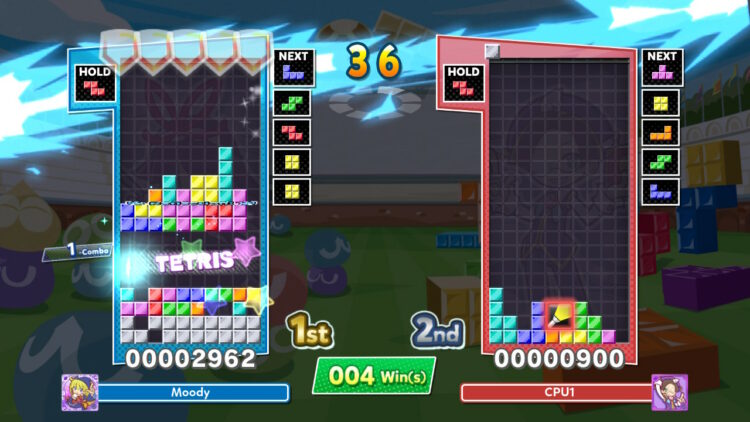
Throughout this review, I’m directly comparing this game to the other games both series currently have available. For Puyo Puyo, that’s mainly Puyo Puyo Champions, but I’m also counting both versions of Puyo Puyo 2 on the Switch, and for Tetris, I’m putting it up against Tetris Effect (and Connected) and Tetris 99. I also want to point out I’m coming at this as a Tetris person; I’ve practiced my Puyo game since the preview I wrote, I’m still not good at it, but I have a deeper understanding now. I actually feel confident in talking about it now.
So, what’s the basic gist of Puyo Puyo Tetris 2? It’s pretty simple, it’s a package with a bunch of modes, some of which can be played with only one game type, but most can be played either with Puyo Puyo or Tetris. I’m not going to go into depth on the mechanics of these games in any way, because explaining their basics would be really boring (do you really want an explanation of the tiers of line clears in Tetris? Does anyone want to read that?), explaining the inner depth would be better suited to a straight-up guide, and writing about puzzle game gameplay just never works. Puzzle games are too abstract for that.
I’ll at least explain the super fundamentals for the sake of writing integrity. In Tetris, you put blocks down, you make a line of blocks, you clear them and get points. In Puyo Puyo, you put four or more of the same colored blob together to clear them and get points. You’ve got two basic forms of both games, a solo mode where it’s just you versus your nerves and skill trying to reach a goal, or against an opponent (another player or the computer) where you both toss garbage blocks at each other to pressure the opponent into losing. In Puyo Puyo, the garbage descends from above, while in Tetris, the garbage rises from below. The twist in this crossover game is that one player can be playing Tetris, while the other can be playing Puyo, and there are even modes where you’ll be swapping between the two games every now and then. It’s a brilliant concept that is still really fun, even if the novelty has worn off.
So, what’s new with the block lines and blob stacks this time? Well, most of the changes in PPT2 are subtle ones. There’s newly drawn portraits and animations, everyone looks a little more consistently on-model, the stylization is more refined and consistent, most of the game is a refinement of the first. A request I personally had from the first game was the ability to change the voices to Japanese, just for some variety in how characters shout the same couple phrases over and over, which I’m happy to report is now available.
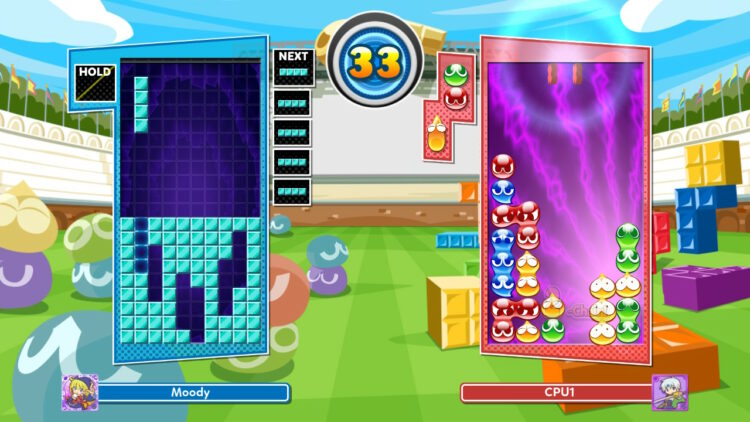
Every mode from the original returns, and there’s some nice variety among them. My favorite is the Party mode, where random items are available on the field for you to get that screw with your opponent in various ways. You might turn out the lights, or cause them to instantly drop each of their blocks, or even just give them bizarre shapes that there’s no possible way they could make a cohesive thing out of.
New to the game is Skill Battle. This is one that has you building a party to take on other parties of characters with unique abilities, and HP and MP meters. It requires a lot more dedication than just selecting it to really get the juice out of it. I personally don’t see the appeal, even after trying it some more. It’s just not my thing, but if the idea of Puyo and Tetris RPG battles appeals, it’s probably for you. I think it just kinda overcomplicates the core game, but it could also be really interesting for the right person. I see the potential for some real interesting fights resulting from the powers within this mode, I’m looking forward to the long, drawn-out battles between top players with their optimized parties.
The big defining feature of PPT2 is Adventure mode, a story-based affair that I also failed to see the appeal in. Gonna be honest, did not spend a ton of time on it. I am not someone who gels with visual novel-type stories, just at all. I’ve tried many VN’s, but it’s never clicked with me fully, and this doesn’t sell it either. Cutscenes play out with portraits on a background, characters talk to each other a lot, you press the A button to advance dialogue a bunch, and then eventually you play some Puyo Puyo or some Tetris, this style of game has never worked for me. Skill Battles spice things up a little, definitely throws some more depth in, but it can also feel totally random if a fight will take five tries or one. The story itself has a juvenile tone, which I can totally get into, but the static presentation does it no favors, in spite of some good voicework.
So the exclusive modes aren’t exactly standout, and it’s highly iterative of the first game. So why buy this in comparison to any other game from either series? Well…that’s actually an interesting question, and the simple answer is: multiplayer.
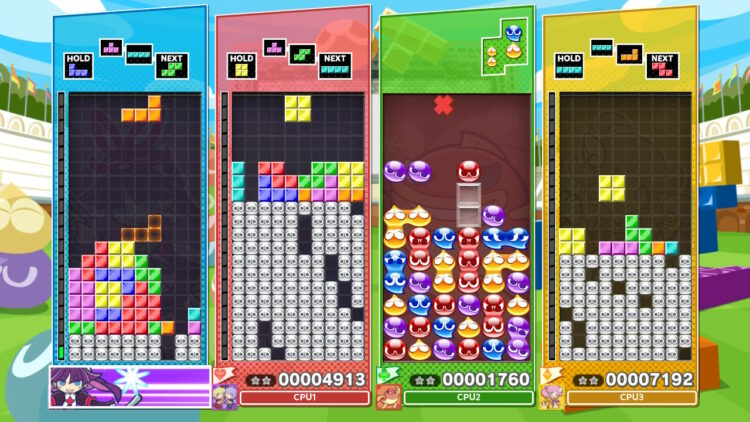
Let’s look at the two major singular Tetris releases from this console generation. First, there was Tetris Effect, which was a fantastic game that I loved, but also had absolutely no multiplayer whatsoever. Not even just a standard two player versus, absolutely nothing. The game was also somewhat light on alternative modes, never really doing anything outrageous in its bonus stuff, while PPT2 has a lot more variety and even a touch of the wild stuff. Then there’s Tetris 99, which is a battle royale game, and has a local two player mode (as an extra paid DLC to a game that’s free with your online subscription), but absolutely no way to simply go against your friends online, and pretty much no alternate modes that’s not a twist on the BR game. Tetris Effect Connected, which greatly expands the content of that game and lets you play with up to four players, just released, but at the time of this writing, is exclusive to Microsoft platforms only. If you bought the game on PS4, you have to buy it on Windows 10 or an Xbox system to get multiplayer, or wait till next year for a free update.
Puyo Puyo Tetris 2 is no bull. You have four player local versus with no limits on modes or combinations of game, plus an extensive online system allowing you to go head-to-head against friends, randoms, or tournaments. No fuss, no catches, it is pure multiplayer puzzle action, which for a Tetris game, has not only been sorely lacking from this generation of systems, but has also been something of a rarity up to this point. For Puyo Puyo, it’s less significant, though.
On the Nintendo Switch, you can play Puyo Puyo 2 for free on the Super Nintendo app for Switch Online users, an emulated copy of the Japanese ROM, or purchase the SEGA AGES Puyo Puyo 2 remaster on the eShop, which is translated. Both versions have local two player and technically also support online play. Neither offers the depth of customization that PPT2 does, but there is an outlier I’m not actually all that sure about: Puyo Puyo Champions. As far as I know, this is a stripped-down package based on Puyo Puyo Tetris, containing only the former’s gameplay, and not as many modes. It’s ten dollars in comparison to PPT2’s $40, and if you’re only into the Puyo stuff, you’re much better off buying that on your system of choice.
Which also brings me to the most important part of deciding to get into PPT2: it is very multiplatform. At launch, it releases on the Switch, PS4, Xbox One, and Xbox Series consoles, with Windows and PS5 versions coming later. Tetris Effect was a PS4 exclusive for a year, but is currently also available on Epic Games store on PC, and the Connected edition with multiplayer is Xbox and Windows only. Tetris 99 is a pure Switch exclusive, with no way to play it anywhere else at all. It’s really a no-brainer at this point if you’re looking for solid puzzle action to throw on at a party or to go against your friends online: this is it. You can play Champions if you’ve got Puyo friends, but if you’ve got people who like puzzle games in general, or only like Tetris, this is almost it for Tetris action…but also not really, because the first Puyo Puyo Tetris exists, is probably half the price or lower, and contains almost everything in this package.
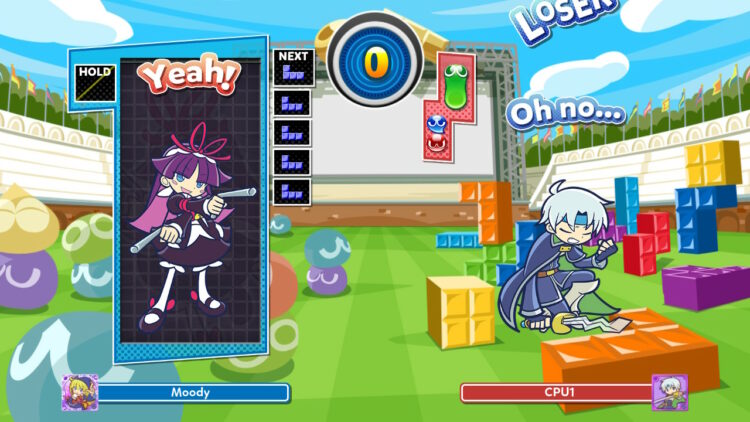
If you have the first game, and you have friends who play it on the same system, you’re not missing a whole lot with this one. Skill Battle could be your thing, and if you really liked the Adventure mode the first time around, there’s enough meat in this one to make a second course worth a shot. The real star of the show though is the competitive scene—if you fancy yourself as good at either of these games, and you’re looking for a way to really get to play with other players of your skill level, then Puyo Puyo Tetris 2 should be on your radar. The game is going all-out with free DLC and continuous updates, building a platform to produce an ongoing online puzzle game experience ala service games in other genres. If you want a game that’s planning to have a long life through refinement of its competitive spirit (the first game did not have a particularly long life thanks to wonky decisions in how the game is played online), then this should be up there for you.
For everyone else…gosh, it’s a weird sell. I kinda feel forced to recommend it as a Tetris fan, because it’s one of the only Tetris games of the generation to have real, proper multiplayer, that’s fully fledged and functional, but I also don’t feel forced to recommend it because the first game exists on nearly all the same systems, has almost the exact same content spread, and almost the same multiplayer. But just almost. Maybe the new stuff is what should put you over the edge to spend the extra twenty bucks. Maybe the promise of new modes, events, characters, etc. over the course of the game’s life should justify buying this over the first. But I just…feel really weird recommending a game based on what it could be later down the road, rather than what it is right now.
There’s also the fact that as a Tetris fan, I’ve seen this series do much crazier and wilder stuff, and I have a real soft spot for that. You’re not going to get anything as exciting and novel as ninety nine Tetris players, or a visual and audio tour de force, or even some wildly inventive mode like stacking blocks to help a little man up a tower. You’re getting something that’s…standard. And I mean, in a way, Tetris is standard. It’s the puzzle game.

But the magic of Tetris is that every version was unique in everything else, it had some weird aesthetic choice, or a particular set of modes, or some twist on the idea. You’d get all kinds of different interpretations of what Tetris should look like, sound like, even play like, but PPT2 is kind of the most spartan, standard Tetris there’s been in forever. It’s kinda just what you expect Tetris to be. It’s sterile. And I think there’s something to be said in a generation where we got something like Tetris Effect, a game that was as bog standard as it could get in how Tetris played, but was so incredibly inventive and innovative in how Tetris could be experienced, that another game with the same gameplay can feel so strangely barren. It certainly doesn’t help the feeling of being standard that, again, the same game basically already released three years ago.
If you want an interesting Tetris game, play Tetris Effect. If you want a very novel Tetris game, play Tetris 99. If you want a pure and solid Puyo Puyo experience, play Puyo Puyo Champions. If you want a fun Tetris game you can play with your friends with almost no fuss, play Puyo Puyo Tetris 2…or Puyo Puyo Tetris, if you’re not a very competitive player.
Positive:
- Great for four player party mayhem as well as one-on-one competitive battling
- Extremely competent version of both puzzle games
- Wonderful art style
Negative:
- Too similar to the first game
- Exceptionally ‘standard’ Tetris experience, this series has been much more interesting
- If you just want Puyo Puyo, you have much cheaper options that are almost as good
 “The Best…In a Vacuum”
“The Best…In a Vacuum”

